While they have a history as edible livestock in South America, in much of the world the common guinea pig is a well-loved pet. These hardy, low-maintenance animals come in a variety of colors and are a good choice for introducing children to pet care since they don’t require as much training or socialization as a dog or cat.
So how do you care for a guinea pig?
Guinea pig care includes the following:
- Providing guinea pig-related supplies such as housing and toys
- Providing vet care and checking for health problems
- Providing fresh food and water daily
- Making sure the guinea pig’s pen is clean
- Socializing the guinea pig through regular handling
Many people, who wouldn’t otherwise choose a guinea pig as a pet, haven’t had a good experience being exposed to them. When raised properly, guinea pigs can be some of the most engaging pets in the household. Keep reading to find out more about these large, colorful rodents and how to keep one.
Table of Contents
What is a Guinea Pig?
The guinea pig (Cavia porcellus) is a South American rodent that was domesticated in the South American Andes as early as 2000 BCE, and these rodents have long been farmed as meat in the mountainous region since other forms of livestock are difficult to sustain on the rocky, uneven soil.
While there are many people in South American who still eat guinea pigs, in the Western world they have become popular “pocket pets” since they are friendly, passive, and a bit easier to care for than many other kinds of rodents.

For these reasons, they have also been historically popular in laboratory experiments, leading the term “guinea pig” to become synonymous with an experimental test subject.
Since their introduction to the pet trade, guinea pigs have been bred into dozens of different colors and variations, so no matter what kind of guinea pig you want, there’s likely to be one in a color or style you’ll like.
Guinea pigs are a great choice of pet for people looking for a companion that is low maintenance, quiet, and doesn’t require a great deal of training or interaction to be happy.
While guinea pigs are social creatures and can be handled enough that they enjoy human contact, they are not as needy as a cat or a dog in that regard.
Supplies Needed for a Guinea Pig
Before you bring a guinea pig into your home, it’s important to already have the supplies you need to take care of the guinea pig ready to go. Here are some of the things you’ll need before you go and pick up your first guinea pig:
- Solid-bottom cage: It is important to choose a cage with a solid bottom rather than a wire bottom because wire-bottomed cages can lead to a painful and dangerous condition in guinea pigs called bumblefoot, which is an infection caused by abrasions from running around on bare wire. Instead, cages with a tray bottom allow you to easily remove the bottom of the cage for cleaning without injuring the guinea pig’s delicate feet.
- Water bottle: Keeping your guinea pig’s water in a water bottle rather than a bowl can prevent it from becoming contaminated with bedding from the bottom of the guinea pig’s cage, which it will inevitably kick into its water and soil it. Water bottles clip to the side of the guinea pig’s cage and allow it to drink from a drip mechanism located at the bottom of the bottle.
- Food bowl: Along with their normal diet of hay, guinea pigs should also be provided with a food bowl that you can keep their treats and other types of food in. Sensory enrichment is an important part of keeping caged pets happy, so make sure your guinea pig has plenty of access to treats and some variety in its diet.
- Hayrack: A hay rack is typically secured to the side of the cage and is a place where you can store hay for your guinea pig to pull out and nibble throughout the day. Hay racks help keep hay from becoming contaminated by the guinea pig’s droppings and urine, which in turn helps prevent disease.

- Hides: Guinea pigs are prey animals and need a place where they can hide away to feel safe and secure. There are many types of commercial guinea pig hides available that are specifically designed for this purpose, but a large overturned flowerpot with a passageway cut into the lip can also serve as a guinea pig house.
- Chew toys: The teeth of a guinea pig grow throughout its life, and because of this it must have access to chew toys in order to help keep its teeth filed down. Overgrown teeth can cause serious health problems in guineas.
- Bedding: There are many kinds of small pet bedding available for guinea pigs and other rodents in a variety of materials such as aspen or recycled paper. One type of bedding that should be avoided is aromatic wood chips such as cedar, which are dangerous to the delicate respiratory systems of rodents like guinea pigs.
- Food and treats: Guinea pig pellets and hay should form the bulk of your guinea pig’s diet, but you can also supplement their diet with a variety of fresh fruits and vegetables such as berries, tomatoes, carrots, cucumbers, green peppers, parsley, salad greens, and melon. There are also commercial guinea pig treats available at most pet shops.

- Playpen: A soft-sided playpen other than the guinea pig’s main cage can be a good investment if you want to keep your guinea pig in the room with you when you’re not in the room where its cage is. Guinea pigs like human company, and setting your pig up in a playpen near your workspace can help give them the ambient attention that they need to feel safe and happy.
If you have all these supplies ready to go before you go to pick up a guinea pig, you can avoid a lot of the stresses associated with acquiring a new pet.
Choosing a Guinea Pig
When you go to pick out a guinea pig, there are several things you’ll want to look out for to ensure that you get a guinea pig that is both healthy and friendly. The last thing you want is to pick out and bond with a guinea pig only to have it sicken and die soon after from an illness it already had in the pet shop or environment it came from.
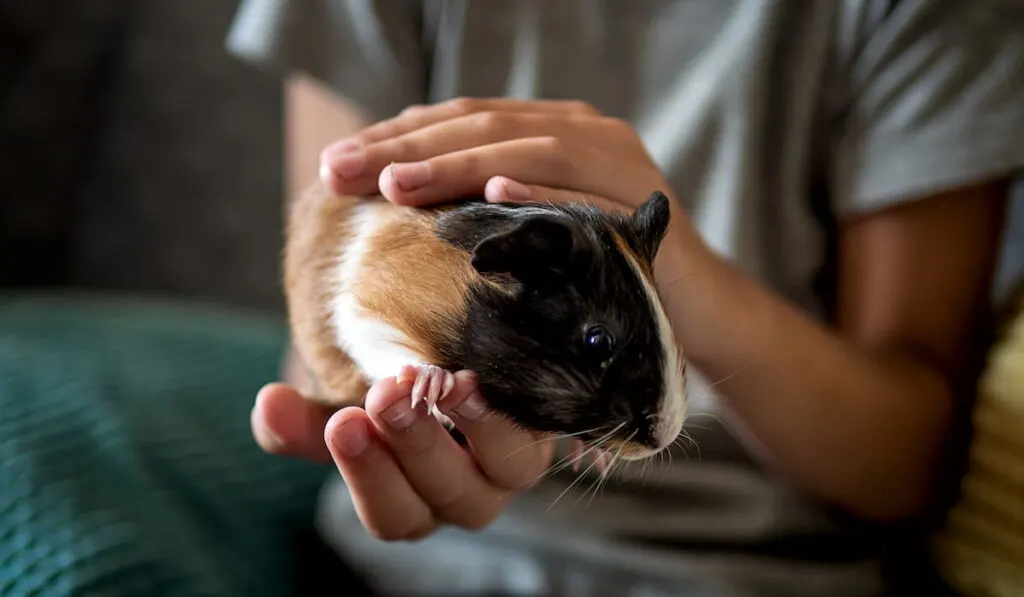
A good way to choose a guinea pig is to stand back and watch the cage of guinea pigs for a few minutes to observe the behaviors of the individuals in it. Here are some of the things you need to look for when choosing your guinea pig:
- Clean-looking coat without bald spots or matting
- Strong teeth that are straight and not overgrown
- No discharge at the eyes, nose, mouth, or rear end
- Quiet breathing (no difficulty breathing, no noisy breathing)
When choosing a guinea pig, you’ll want to look for one that isn’t overly fearful or agitated when you approach the cage. Instead, look for a guinea pig that appears both calm and alert and doesn’t panic when you attempt to pick it up.
If the place you are choosing a guinea pig from has any other guinea pigs that appear ill or the cage itself seems to be neglected, you should probably go looking for a guinea pig somewhere else. Guinea pig diseases tend to be contagious, so chances are if one guinea pig in the cage is sick, they’re all sick.
Be sure that the place you’re sourcing your guinea pig from separates the piglets into males and females. While buying a same-sex pair of guinea pigs together is a good idea so that they can keep each other company, the last thing you want is an unexpected litter of guinea pigs.
Acclimating Your New Guinea Pig
Once you’ve chosen a guinea pig, it’s time to bring your guinea pig home. For the first day or two that you have your guinea pig, it’s a good idea to just put them in their enclosure and let them get a feel for their new surroundings in a quiet, slightly darkened room. This will keep the guinea pig calm and prevent it from becoming frightened by too much unfamiliar handling.
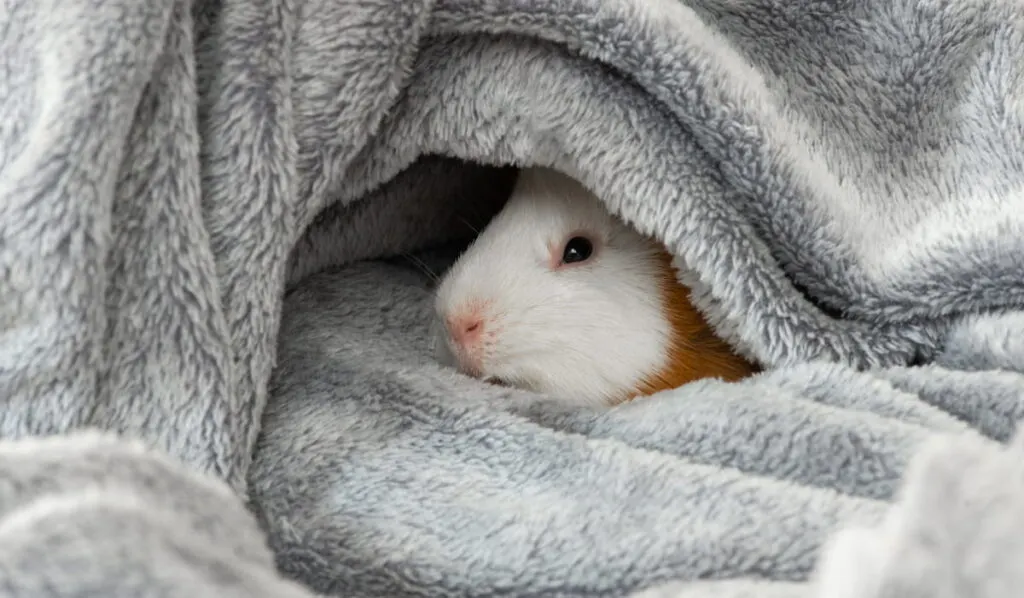
After your guinea pig has had some time to adjust to its new cage, you can begin the process of taming your guinea pig. At first, you should just spend some quiet time in the same room as the guinea pig doing something else, like reading a book or watching television at a low volume. This will get the guinea pig used to your presence.
When the guinea pig has become accustomed to your presence in the room and has stopped hiding every time you approach, this is your opportunity to start gently handling the guinea pig to get it used to being held, stroked, and carried.
Be very careful handling your guinea pig at first, since frightened guinea pigs can bite hard if distressed and they are easily injured if dropped. Do not ever let small children handle a guinea pig without intense hands-on supervision to prevent a tragedy.
Veterinary Care for Guinea Pigs
Like any other pet, guinea pigs require regular veterinary care in order to avoid serious health problems. They don’t require vaccinations like dogs and cats, and it isn’t recommended that they are spayed or neutered due to the health risks involved, but they can still have medical issues that need to be seen by a vet.

Here are some of the reasons you need to bring your guinea pig into the vet for check-ups and care:
- Malnutrition: It is vital to make sure that guinea pigs get a variety of foods to prevent vitamin deficiencies that can lead to bone, tooth, and fur issues, as well as general ill health. A vet can recognize the subtle signs of malnutrition and prescribe vitamins to prevent them.
- Respiratory illnesses: Because of their bedding, guinea pigs can be susceptible to bacterial respiratory illnesses like pneumonia if their cages aren’t kept clean enough. Signs of respiratory illness include lethargy, loss of appetite, labored breathing, or noisy breathing (wheezing).
- Abscesses: Abscesses in guinea pigs can be caused by fighting (bite marks) and puncture wounds caused by sharp points in the enclosure. These wounds can then become infected by ambient bacteria in the environment, especially if the guinea pig is in a dirty pen. Guinea pigs should be checked regularly any signs of abscess such as lumps, which can occur anywhere on the animal.
- Pododermatitis (bumblefoot): Bumblefoot is one of the most common illnesses observed in guinea pigs by veterinarians and is the result of abrasions and subsequent infection in their exposed bare feet on wire or other rough surfaces. To prevent bumblefoot, the guinea pig’s cage should be cleaned thoroughly at least once a week and a solid cage bottom should be used.
- Dental issues: Guinea pigs that don’t have access to the types of foods capable of wearing down their teeth can develop overgrown teeth that will eventually prevent them from being able to eat. If a guinea pig’s teeth are becoming overgrown, a veterinarian can manually file them down to enable the guinea pig to eat normally again.
- Trauma: Unfortunately, it is a common occurrence that guinea pigs are dropped from chest height, attacked by another animal in the household, or accidentally stepped on, all of which can cause major injury or death to the animal. In case of trauma, a guinea pig should be taken immediately to a vet for examination to make sure that internal damage wasn’t caused even if there are no obvious injuries.
Guinea pigs should go to the vet at least once a year for a physical check-up to make sure that they are in good health. It can sometimes be easier for a trained veterinarian to see signs of illness or injury that aren’t as obvious to an untrained layman or pet owner.
Grooming for Guinea Pigs
Short-haired, smooth-coated guinea pigs are fairly low maintenance when it comes to grooming, but there are other types of guinea pigs, such as Teddy guinea pigs, which have specialized coats that require extra care.
To groom a guinea pig, you should have both a soft bristle brush and nail clippers. Once a guinea pig has become acclimated to your home, it’s a good idea to handle the guinea pig regularly so that regular grooming like brushing and nail clipping doesn’t become a battle.
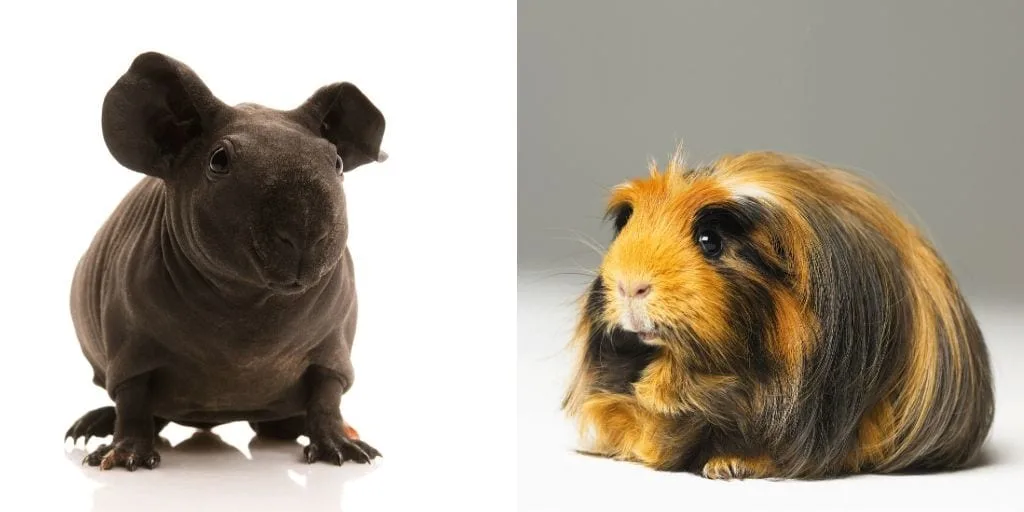
Regardless of coat type, all guinea pigs should be regularly brushed, and their nails should be kept short to prevent scratching. Well, with the exception of hairless guinea pigs which don’t require any brushing.
Abyssinian guinea pigs are a special breed of guinea pig where the hair of the guinea pig changes directly abruptly, causing it to stand up in tufts and to grow in patterns known as “rosettes”.
These guinea pigs should be combed from the interior of the rosette outward, rather than brushing straight down like you would a short-haired guinea pig. This can prevent the pattern of the guinea pig’s coat from becoming damaged.
Daily Care for Guinea Pigs
The daily care of guinea pigs is fairly simple. Here are the things that need to be done each day to care for your guinea pig:
- Any obviously soiled bedding should be removed
- Hay and food should be replaced after the food bowl is cleaned out
- The water bottle should be cleaned and refilled
- Allow the guinea pig time out of the cage to play and explore
- Socialize with your guinea pig and inspect it for injury or illness while petting
In addition to these tasks, the guinea pig’s enclosure should be deep cleaned once a week to prevent the accumulation of bacteria in the cage that can cause respiratory illness and other guinea pig diseases.
To do a deep cleaning, all bedding should be removed and replaced. The interior of the guinea pig’s cage should also be disinfected before filling the cage bottom with fresh litter.
Above all, it’s important to remember that guinea pigs are social creatures. While they might require less social interaction than a dog or a cat, a guinea pig will still appreciate regular social interaction either from its owner or another guinea pig to remain happy and engaged.
Another thing to take into consideration is that guinea pigs greatly prefer a set schedule, so it’s a good idea to get into the habit of feeding your guinea pig and handling it at roughly the same time every day. This will help the guinea pig to feel more comfortable around you, as these animals do not like surprises or breaks in their daily routine.
Feeding Your Guinea Pig
The staple of a guinea pig’s diet consists primarily of two things: timothy hay and guinea pig pellets . Both hay and pellets are easily sourced through pet stores or online outlets like Amazon. Guinea pigs require both, as a high fiber diet is crucial to maintaining their good health.

While it is important to add some fruits and vegetables to your guinea pig’s diet both for enrichment purposes and as a vital source of vitamin C, fresh fruits and vegetables should not make up more than twenty percent of your guinea pig’s diet. (source)
You should never feed your guinea pig human foods such as sugary foods, caffeine, or simple starches, as these foods can cause serious stomach problems. Overall guinea pigs do not do well with sudden changes to their diet, so this should be avoided whenever possible.
New fresh foods such as fruits and vegetables should be introduced slowly and in small amounts, especially if they are high in sugar like melon or berries.
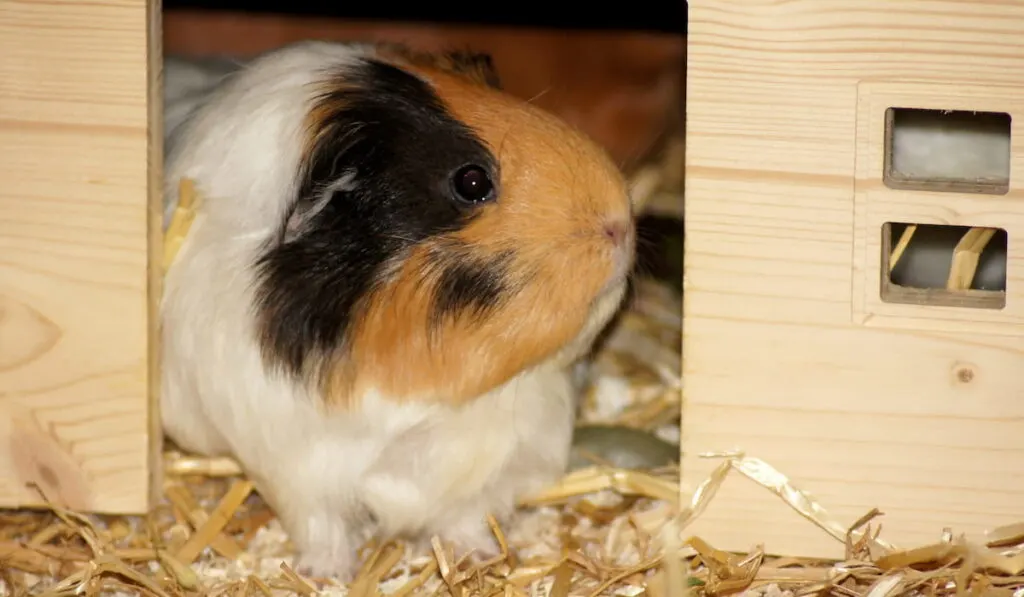
Housing Your Guinea Pig
It is important before you decide to buy a guinea pig that you understand their housing needs. According to the Humane Society, the cages that are sold for guinea pigs in pet stores are often too small.
It might be tempting to go with a small cage early on for a guinea piglet with the intention of upgrading later on, but guinea pigs really don’t like changes to their routine and it’s better to get your guinea pig a cage large enough for it as an adult.
If you have multiple guinea pigs, it can even be useful to set up a room of the house as “their” room, so that the guineas can be allowed to roam more or less freely. This greater access to space not only results in happier guinea pigs, but it also makes for cleaner enclosures.
One important thing to keep in mind when situating your guinea pig cage or enclosure is that it needs to be situated well away from any sources of heat, such as a vent or fireplace.
Guinea pigs are unable to perspire, and this can lead to them developing heatstroke in a hurry if they are placed in a warm area they can’t escape from.
Guinea pig cages should also not be located near loud sources of noise such as blaring televisions or stereos, as these animals have very sensitive hearing and loud noises can both stress and frighten them.
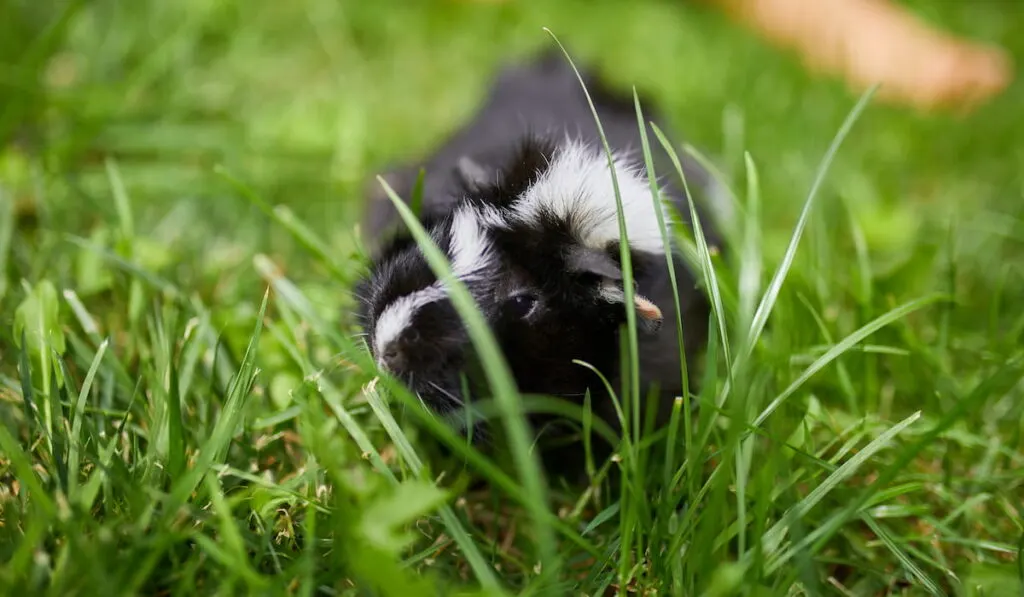
Common Questions about Guinea Pigs
Even though guinea pigs are a popular pet, there are still many people who are unfamiliar with them. Here are the answers to some questions that are commonly asked about guinea pigs and their care:
- Is it legal to eat guinea pigs in the United States? It is legal to eat guinea pigs in the United States and even raise them as a source of homestead livestock, similar to how rabbits are raised for meat. However, it is hardly a popular practice, and most people in North America keep guinea pigs purely as companions.
- Are guinea pigs nocturnal or diurnal? Guinea pigs are crepuscular, which is a fancy way of saying that they are most active at sunrise and sunset. This means that you should schedule any activities such as play around these time periods and provide resting time in a dimly lit room during the day and night.
- Why is my guinea pig vibrating? Usually, that means he or she is happy! Guinea pigs thrum or vibrate when pleased and this behavior is seen as the equivalent of a cat purring. However, deeper vibrations can also indicate mounting annoyance such as irritation at being groomed or held. Once you spend a lot of time with your guinea pig, it becomes easier to interpret them.
- Do you have to get more than one guinea pig? While guinea pigs are group animals and benefit from being with their own kind, guinea pigs need to be raised in same-sex couples if they are going to be kept together. Mixed-sex couples will breed and result in unwanted piglets. If you keep a guinea pig on its own, you’ll need to take up the slack with regards to socialization.
- Can you keep guinea pigs outdoors? It is not usually recommended to keep guinea pigs outside, as they don’t do well with drastic temperature fluctuations and can quickly become ill at temperatures either above or below 65-75 degrees. Even as livestock in South America, guinea pigs are frequently kept indoors. You can, however, take them outside to “play” if supervised at all times and contained.
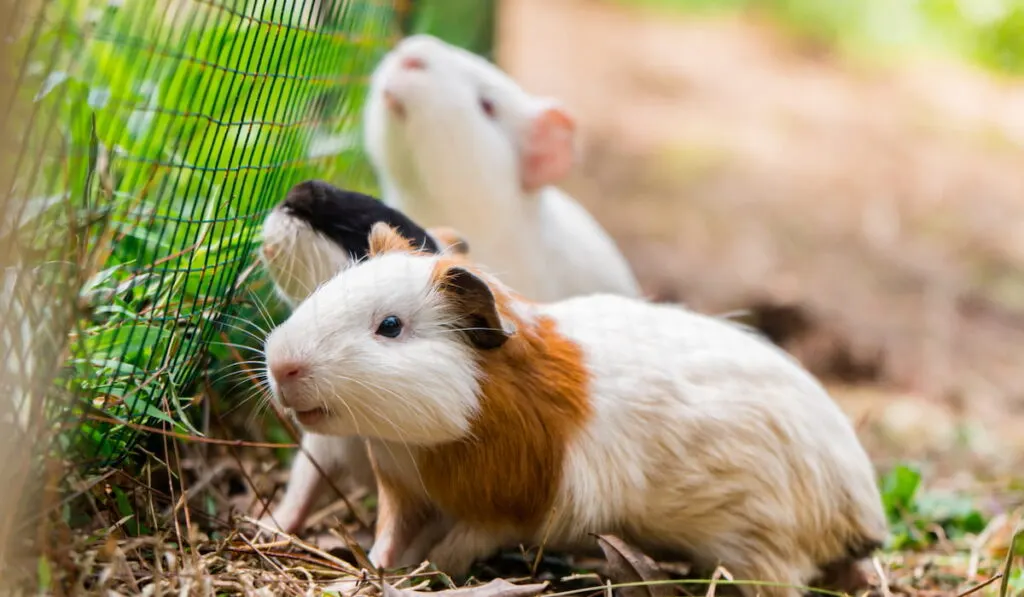
- Are guinea pigs intelligent? Guinea pigs are an intelligent animal and can be trained similarly to a cat or dog, even to the point of being trained to a litterbox. This means that a guinea pig requires daily stimulation to avoid becoming bored and unhappy.
- Do guinea pigs like the water? Guinea pigs don’t swim well due to their tiny legs and stocky bodies, and they aren’t known for liking water. Like cats, guinea pigs largely groom themselves and will typically protest if given a bath.
- Do guinea pigs sleep with their eyes open? Yes! If you ever see your guinea pig staring blankly out into space in a cozy-looking position, there’s a good chance he or she is actually taking a nap. Like most prey animals, guinea pigs must be hyper-vigilant against predators, and that means learning to sleep with both eyes open.
Guinea pigs are fascinating animals that may not be as popular as dogs and cats when it comes to household companions, but they have a lot to offer someone who wants a bit more unusual pet that doesn’t require nearly as much training or care.
Guinea Pigs Are Easygoing Pets
Unless you were raised with a guinea pig in your household growing you, you might be unaware of just what great little pets these rodents can be when they’re well cared for. The personality of these fuzzy critters is so gentle and friendly that many people would never believe they are still commonly eaten in some parts of the world.
Guinea pigs aren’t a “set it and forget it” pet—they require just as much love and attention as any other animal in your household. But if you put the time, energy, and resources into keeping your little friend supplied and happy, you’ll be astounded at how much affection you’ll receive in return.
